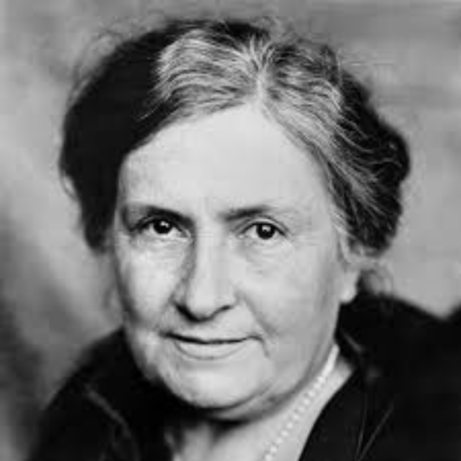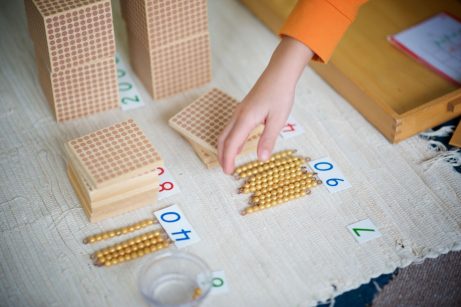The Montessori Curriculum

Montessori schools don’t divide their school days individual subjects; instead, the students choose from individual lessons and exercises available to them throughout the day. So how is the curriculum organized?
Dr. Montessori herself organized her curriculum into the following five areas. Continuing her work, Montessori teachers now study these areas during their training and carefully arrange and organize their classrooms so that the layout of the space itself helps students orient themselves in the structure of the curriculum.
Practical Life
Practical Life forms the heart of the Montessori classroom. In the Nido environment, toddlers learn how to mop floors or water plants; in Casa, children practice pouring water without a spill or peel, slice and serve fruits for snack. In Elementary, the nature of Practical Life shifts and turns from classroom activities to outside life (although students are still certainly expected to wipe shelves and wash their water cups) and includes activities such as going to the post office to research package shipping costs, or calling to make a vet appointment for the classroom pet.
The once-common idea that “practical skills” – like sewing on a button or balancing a checkbook – being a part of education is reflected here, but gains a whole new appreciation and depth. Because although the exercises are useful in themselves, the purpose of Practical Life is not truly to learn how to polish a wooden bowl or grind coffee in a hand-cranked grinder.
Instead, the focus is on the mental, emotional and physical benefits that the exercises have on the children. By achieving concrete, useful tasks, each student gains independence, confidence, and a positive self-image. They nurture their identity as capable workers and learners, who can master the tasks of the environment, take care of themselves and others, and work for the benefit of their community.
Sensorial
The purpose of the sensorial curriculum is to awaken, stimulate and refine the sensorial perception of the children.
In its essence, learning occurs through a human being’s interaction with the environment. Our sensory perception is the only way we receive information from the environment, and so it stands to reason that refining and perfecting this perception will deepen our learning and understanding of the world around us.
This was Dr. Montessori’s theoretical foundation in developing the sensory curriculum. She was delighted to observe that young children responded to this curriculum with passionate interest that soon turned to concentration and meaningful work. The satisfaction and gratification that young children experience through the work of refining their senses stands as proof of its developmental value.
The sensory activities include exercises to stimulate visual, tactile and auditory discrimination, but also refining the olfactory and gustatory senses (taste and smell), baric and thermic senses (the perception of weight and temperature) and the stereognostic sense (the perception of shape when touching an object). In practice, this includes grading and scaling activities, when children for example order colour tablets by shade or sandpaper blocks by roughness. Another format has children identify objects by a single sense, such as when blindfolded students use their stereognostic sense to select particular geometric solids from a bag.

Explore the fundamentals of Montessori parenting with this free video by Sylvia Arotin, offering insights and strategies to empower and educate your child.
Language
Language is a fundamental human activity and our level of language skills determines not only our participation in society, but even our cognition and perception of the world itself. As such, we pay a lot of attention to language expression in Montessori classrooms!
The first step is acquisition of spoken language through conversation, verbal exercises and games, and vocabulary material. As we know, language development begins long before birth as likewise, and so should language education. Aside from the physical materials (books, language cards and objects), much of the early spoken language curriculum is “invisible” – it lies in the training teachers receive to speak and listen to children in ways that promote learning and understanding.
In Casa, we add a whole exciting side of language – reading and writing. Carefully designed materials and movable alphabets allow children to carry out the mental work of decoding and encoding written language even if the manual work of writing poses an unsurmountable challenge still.
In Elementary, the focus shifts to the structure and laws of language, and children work on word study, sentence analysis and further grammar concepts. Gradually, they move from the concrete materials that helped them visualize and organize their knowledge, towards abstract understanding.
Mathematics
Just like with Language, Dr. Montessori included the Mathematical Mind as a fundamental Human Tendency that shapes our way of living and thinking. All too many children and adults might be ready to disagree with this statement, holding a grudge against maths because of a bad experience at school; well, the Montessori system works to avoid those pitfalls.
First, we begin by offering children exercises that showcase isolated concepts, allowing them to practice to their own satisfaction. Through concrete, hands-on materials, the students build a rock-solid foundation for further learning. The self-correcting materials are designed to show a child when a mistake has been made, removing the need for a teacher to criticize a student’s work. Instead, students experience and internalize challenges and successes as they learn concept after concept through their own purposeful activity.
The math materials begin with simple, sensorial exercises designed to isolate and demonstrate characteristics such as gradations in size or value; in fact, a case could be made for considering most sensorial and practical life curriculum as preparation for math as children experience volume, sequence or amount with them. In Casa, students learn the meaning of math symbols and begin manipulating numbers, with concrete representations of spindles, beads or blocks. In Elementary, students continue using sophisticated sets that allow them to physically calculate more advanced operations (such as multi-digit division) but also work towards automation and abstraction.
Culture
The inclusion of “culture” in the list of core areas may raise eyebrows or smiles, however Dr. Montessori intended the simple world to encompass all of the various disciplines of accumulated human knowledge. As such, Culture refers to lessons ranging from zoology to chemistry to history. Instead of prescribed lessons, the Montessori classroom includes materials, books and resources designed allow practice and mastery of key concept but intended to encourage curiosity and individual research.
Dr. Montessori advocated for a new approach to presenting Culture: from global to local. For example, in Geography the Casa children are first introduced to the concept of the planet Earth, and study continents and nations before moving onto smaller units. As such, all new knowledge can be integrated into an existing, orderly framework the child has established prior. This fits with the preferences of young children who are excited to learn about “everything”!
In Elementary, the children are also introduced to a new type of cultural lessons with Cosmic Education and the Great Lessons – impressionistic lessons designed to capture the vivid imagination of the old Elementary student and promote an attitude of awe and fascination with our world.
Art and Music
Visual Arts and Music, like Language and Mathematics, are also considered in Montessori to be basic human tendencies. We believe not only that they are essential to sustain our souls, but that active participation in the Arts is just as developmentally inevitable and necessary for children, as eating or sleeping.
As such, instead of an allocated time and space, the Arts are integrated throughout the Montessori classrooms. We sing and dance throughout the day, and various art supplies are available for both independent expression or use within other lessons and exercises, such as when an Elementary student illustrates their research findings on dinosaurs. Music theory begins with Sensorial auditory exercises and continues through beautiful dedicated materials including the Bells and the Tonal Bars; Art and Music History is a part of Culture.
Montessori also advocates for using real, fine-art quality supplies and quality musical instruments for children, rather than relying on musical toys and children’s crayons and markers. The purpose of this is for children to experience the full sensory pleasure of quality materials, and the tonal clarity of real instruments.
A special mention must go to two “subjects” that, whilst technically not their own areas, are key components of the Montessori curriculum.
* Grace and Courtesy
Grace and Courtesy is a subset of Practical Life that focuses on social interaction. As such, most of its exercises are of the kind that isn’t practiced by a child on a material, but between children and the teachers. These include things such as saying please and thank you, offering refreshments to a visitor or excusing oneself from a conversation. In Casa, these are practiced – joyfully and with great interest – just like any other lesson!
However, the Grace and Courtesy curriculum reaches further and deeper than simple manners. Its fundamental intention is to guide teachers, and by extension children as well, to act and treat each other in ways that demonstrate and uphold the values of kindness, respect and dignity in all our interactions. Its purpose is to help children develop into peaceful, compassionate human beings and citizens.
* Movement
Dr. Montessori could not have been clearer about the inextricable connection of the human mind and body, and of the importance of movement in human development. To put it as simply as possible, we find movement a fundamental, inevitable part of any learning activity, and movement is given special place and attention in Montessori classrooms.
Physical Education, on the other hand, has traditionally not been part of the Montessori classroom. The movement that we speak about is not exercise to promote physical health but controlled, purposeful activity in the environment, promoting learning – such as the complex movement of a hand manipulating the movable alphabet or the careful coordination of a toddler carrying a bucket of water.
However, a rising number of voices are calling for integrating Physical Education into the Montessori classroom. Even staunch traditionalists can admit that the lifestyle of Dr. Montessori’s students a century ago differed significantly, in terms of physical exertion, from that of our students today; there is a gap between children’s physical needs and the exercise they get, that wasn’t there before. Besides, national curricula now usually demand a unit of Physical Education even in most liberal jurisdictions.
For Physical Education to match the values of Montessori education, it must be experiential, child-led, individualized and non-competitive; a number of programs have arisen in recent years that respect these values and fit well into the rest of the classroom. However, none of these programs and exercises replace the value of purposeful movement integrated throughout the entire rest of the curriculum.
Montessori Beginnings
YOUR ULTIMATE
MONTESSORI PARENTING COURSE
FOR ZERO TO THREE
Gain clarity and confidence in your parenting to raise a resilient, independent and joyful child.


